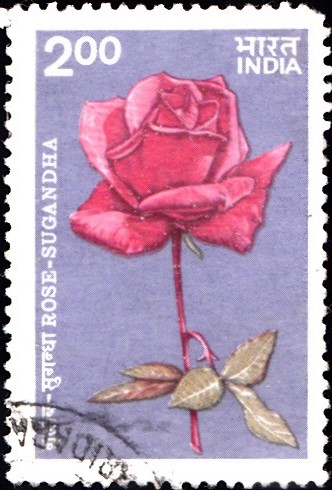
Roses in Australia
Complete Set of 4 nos of postage stamps on the Hybrid Roses of Australia : Marjorie Atherton, Imp, Minnie Watson and Satellite :




Issued by Australia
Issued on May 19, 1982
Designer : Betty Conabere [Mrs. Elizabeth Conabere was a botanical illustrator who lived and worked in an elderly house surrounded by a garden, in the Victorian country town of Mansfield. In 1969, on completing drawings of alpine plants for the National Herbarium in Melbourne, she commenced work on the two-volume limited edition book ‘Wildflowers of south eastern Australia‘ published in 1974. The original paintings for this work were purchased by the Victorian Ministry for the Arts, and presented to the La Trobe Library. Mrs. Conabere had also worked on Illustrations for the Victorian Lands Department depleting plants which have been declared noxious weeds. Her 1982 stamp commissions for Australia Post included both ‘Roses in Australia’ and ‘Eucalypts‘.]
Typographer : Bruce Weatherhead, Melbourne
Type : Stamp, Mint Condition
Colour : Multi colour
Denomination : 27c, 40c, 65c and 75c
Stamp size : 26 mm x 37.5 mm
Perforation : 13 x 13¼
Paper :
27c – litho–chromo stamp paper incorporating luminescence,
others – APWH stamp paper
Sheet content : 100 (issued)
Printing process : photolithography on a four–colour Roland Rekord press
Printer : Leigh–Mardon Pty Limited, Melbourne
About :
- Marjorie Atherton, Imp, Minnie Watson and Satellite, the four rose varieties depicted on the special stamp issue introduced on 19 May 1982, were selected in consultation with the National Rose Society of Australia. Each of the four varieties is distinctive in the colour, form and fragrance of its flowers; and all four are outstanding examples of hybrid roses developed in Australia.
- Hybridisation, the cross-breeding of different varieties to produce a new specimen, is the method used to produce most modem rose varieties. Such cultivation has enabled the promotion of such desirable qualities as hardiness, the ability to resist disease, variety of colour and continuous flowering. A new variety may take years to perfect; usually followed by the presentation of the new rose at a public flower show. Rose shows and festivals are held in the spring and summer months in all the Australian States, organised by the State rose societies. Annual rose festivals are held at Benalla, Victoria and Glen Innes, New South Wales.
- Roses are grown in three forms : bush, standard and climbing (including pillar roses and ramblers). While some varieties do equally well as bush or as standard roses, others are best suited to one particular form. Climbers may be naturally climbing in habit, or may be ‘sports’, the name given to climbers which derive originally from bush forms. Miniature roses are a category of increasing popularity, available as bushes and standards, and in some cases as climbers. The four roses depicted on the stamps may be grown in either bush or standard form, but are not available as climbing roses.
- The blooming habit of roses has been classified as ‘cluster flowering’ and ‘large flowering’. Cluster flowering roses were formerly known as floribundas. Imp is a cluster flowering rose, and Marjorie Atherton, Minnie Watson and Satellite are large flowering varieties.
- One of the most popular roses ever cultivated is known as Peace, a slightly fragrant variety with large golden yellow petals flushed with pink. Raised by the Meilland family during the Second World War and originally named Madame A. Meilland, Peace was smuggled out of occupied France to the USA, and introduced to the public in 1945. Both Marjorie Atherton and Imp include the Peace rose in their pedigrees.
- The long stemmed Marjorie Atherton rose is a fragrant, disease resistant plant with dense foliage. The double blooms are deep, maize yellow. Marjorie Atherton was raised in 1978 by Mr. R. J. Bell of Harkaway, Victoria, by crossing Mount Shasta with Peace. Mount Shasta is a tall growing, white, fragrant variety with a slight tint of pink; and Peace is yellow, with rose pink-edged petals. Marjorie Atherton is the name of Mr. Bell’s sister.
- Imp is an unusual rose, with long-lasting clusters of flat, semi-double blooms. Each of the imbricated, or overlapping, white petals is heavily margined with a band of deep red. This hardy plant with dark green foliage was developed in 1971 by Mr. George Dawson, of Bunyip, Victoria. Peace occurs several generations back in Imp’s pedigree; Peace crossed with Independence produced Grand Gala; Grand Gala crossed with Ma Perkins produced Daily Sketch. Mr. Dawson crossed Daily Sketch, a bushy plant with pink and silver clusters of large double blooms, with Impeccable, a very fragrant variety with deep velvety red double flowers. The name Imp derives from the first three letters of Impeccable.
- The semi-double blooms of Minnie Watson are light salmon pink with a slight fragrance. A compact bush is formed with glossy foliage, and the buds are an attractive globular shape. Mr. R. Watson of Warrane, Tasmania, raised Minnie Watson in 1965 by self-pollination of Dickson’s flame. Seedlings have been raised from self-pollinated seed and from chance pollination by insects, but the deliberate crossing of a variety with itself is most unusual. Dickson’s flame is a slightly fragrant rose with scarlet clusters. The Minnie Watson rose was named after Mr. R. Watson‘s mother.
- Satellite is an early flowering rose with very fragrant double blooms of a deep crimson colour. The vigorous upright and compact plant has attractive glossy foliage. Satellite was cultivated in 1958 by Mr. J. L. Priestly of Melbourne, by crossing Editor Mcfarland with William Harvey. Editor Mcfarland is a glowing pink double rose with very fragrant blooms; and William Harvey is scarlet and strongly fragrant. The name Satellite was chosen by Mr. Priestly to reflect topical interest in the Russian ‘Sputnik‘ at the time that the rose was raised.







[…] apart from the design of the Christmas issue, he is accredited with the typography of the ‘Roses in Australia‘ and ‘Historic Post Offices’ stamps. His work covers most fields of illustrative design, […]
[…] apart from the design of the Christmas issue, he is accredited with the typography of the ‘Roses in Australia‘ and ‘Historic Post Offices’ stamps. His work covers most fields of illustrative design, […]
[…] been declared noxious weeds. Her 1982 stamp commissions for Australia Post included both ‘Roses in Australia‘ and […]